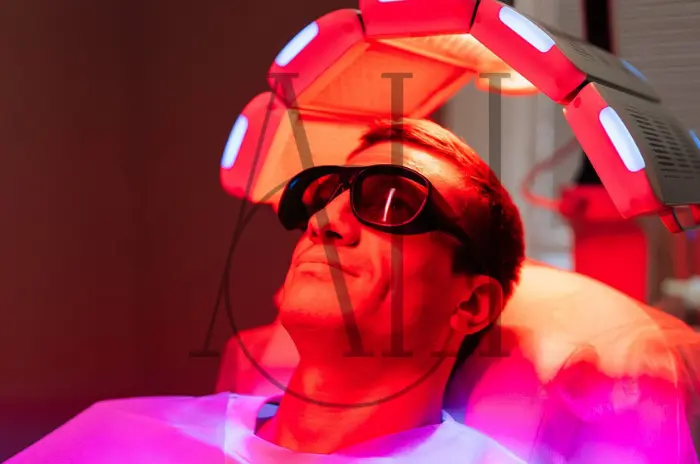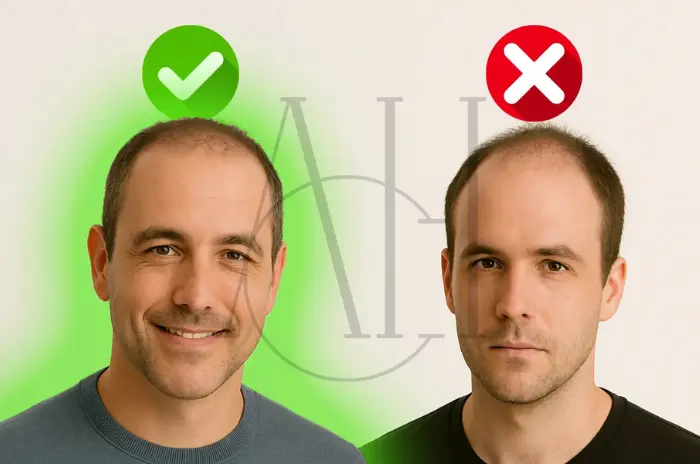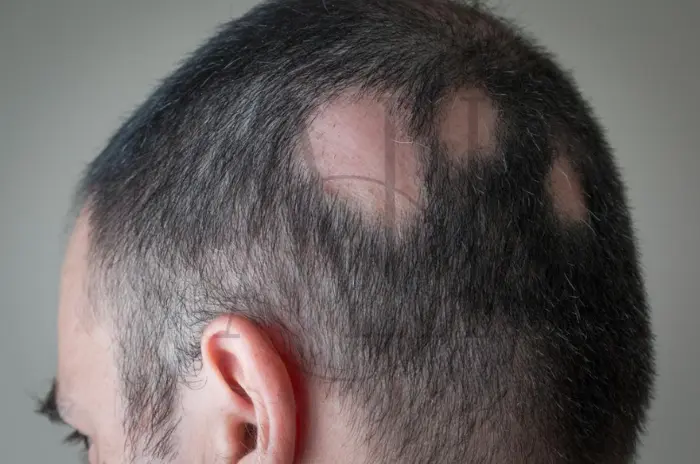Red Light Therapy (RLT) is a non-invasive treatment that uses low-level red or near-infrared light to stimulate cellular function and promote healing. In the context of hair growth, RLT targets the hair follicles with wavelengths typically between 630–670 nm, penetrating the scalp to improve blood circulation, reduce inflammation, and enhance cellular energy production (ATP). This stimulation can encourage dormant hair follicles to shift into the active growth (anagen) phase.
Table of Contents
ToggleDoes Red Light Hair Growth Stop DHT?
Red Light Therapy does not directly block DHT (dihydrotestosterone), the hormone responsible for androgenetic alopecia (pattern baldness). However, it plays a supportive role in managing DHT effects by:
- Increasing blood flow to hair follicles, allowing better nutrient delivery.
- Improving follicle resilience against DHT-related miniaturization.
- Reducing oxidative stress and inflammation that can exacerbate hair loss.
What Is Low-Level Light Therapy (LLLT)?
Low Level Light Therapy (LLLT) is a specific form of red light therapy using laser or LED devices to deliver light at precise wavelengths and intensities. FDA-cleared LLLT devices are widely used for scalp treatments. Unlike high-intensity lasers, LLLT devices are designed to be safe for home or clinical use, without heating tissues or causing damage.
How Do LED Caps Differ from LLLT Devices?
1. Light Penetration:
- LLLT devices often use laser diodes, which penetrate deeper into scalp tissue.
- LED caps use light-emitting diodes, offering broader coverage but shallower penetration.
2. Energy Output:
- Laser-based devices are more focused and intense.
- LED-based caps distribute energy over a wider area but with less intensity per point.
3. Clinical Evidence:
- LLLT laser devices generally have stronger support in scientific studies.
- LED caps are effective but may require longer or more frequent use.
How Does a Low-Level Laser Therapy (LLLT) Device Work?
LLLT devices deliver light energy to the scalp using laser or LED sources. The light stimulates mitochondria in cells, increasing ATP production and encouraging the transition of hair follicles from the telogen (resting) phase to the anagen (growth) phase. Consistent use of LLLT may thicken hair, reduce shedding, and increase the density of active follicles.
Causes of Hair Loss
Hair loss can result from various internal and external factors:
- Heredity – Genetic predisposition, especially androgenetic alopecia.
- Age – Hair growth rate slows, and follicles shrink with age.
- Hormonal changes – Particularly during menopause or pregnancy.
- Medical conditions – Thyroid disorders, alopecia areata, and more.
- Stress – Can trigger telogen effluvium, a temporary shedding phase.
- Tight hairstyles – Traction alopecia from sustained pulling on hair.
What Does the Science Say About Red Light Hair Growth?
Multiple studies support the use of RLT for treating hair loss. Research indicates that red light at specific wavelengths can significantly increase hair count, density, and thickness in individuals with androgenetic alopecia. One study in 2014 published in Lasers in Surgery and Medicine showed a 39% increase in hair growth over 16 weeks using an FDA-cleared laser cap.
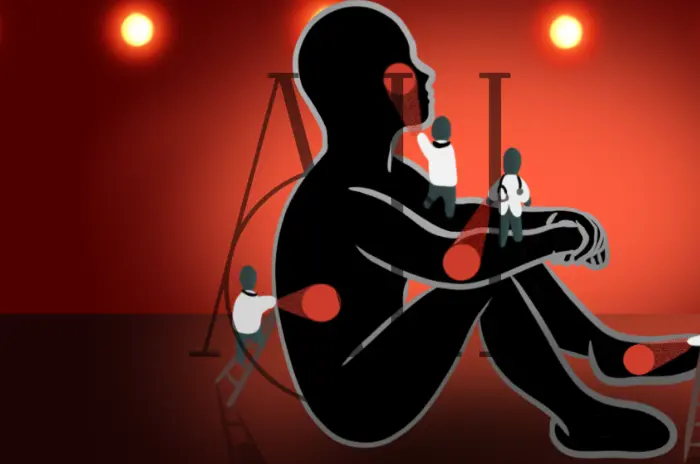
How Does Red Light Therapy Hair Growth Work?
-
Stimulates ATP production in follicle cells.
-
Improves scalp circulation, delivering oxygen and nutrients.
-
Reduces inflammation, promoting a healthier scalp environment.
-
Extends anagen phase, leading to longer periods of hair growth.
What Are the Benefits of Red Light Therapy?
Red Light Therapy for Dementia
Clinical studies suggest near‑infrared wavelengths (810–850 nm) penetrate the skull and stimulate mitochondrial function in neurons. By increasing cerebral blood flow and boosting ATP production, photobiomodulation may enhance memory, attention span, and overall cognitive performance—especially in early‑stage Alzheimer’s disease and mild cognitive impairment.
Red Light Therapy for Pain
RLT reduces the production of pro‑inflammatory cytokines while stimulating endorphin release. As a result, chronic joint and muscle pain—such as fibromyalgia, lower‑back strain, or post‑exercise soreness—can diminish within a few sessions, improving mobility and overall quality of life.
Red Light Therapy for Arthritis
Controlled trials report significant decreases in joint stiffness and swelling when 660‑nm light is applied to arthritic areas. Enhanced microcirculation accelerates the removal of inflammatory metabolites, while increased collagen synthesis supports cartilage repair and joint function.
Red Light Therapy for Tendinopathy
By up‑regulating fibroblast activity, red light accelerates collagen remodeling in damaged tendons (e.g., Achilles or rotator‑cuff injuries). Athletes often experience faster recovery times and reduced re‑injury rates when combining RLT with physiotherapy.
Red Light Therapy for Hair Loss
Photons at 650 nm boost dermal‑papilla cell metabolism and lengthen the anagen phase. Clinical data show up to a 40 % increase in terminal hair count after six months of consistent use—especially when combined with adjuncts like minoxidil or pumpkin‑seed oil.
Red Light Therapy for Skin Rejuvenation
RLT stimulates fibroblasts to produce new collagen and elastin. This visibly reduces fine lines, tightens pores, and evens skin tone. Regular sessions can also speed wound healing and fade scars or hyperpigmentation.
Red Light Therapy for Acne
At 630 nm, light penetrates sebaceous glands, curbing excess oil production and neutralizing P. acnes bacteria. Inflammatory lesions shrink more rapidly, leading to clearer skin without the dryness associated with topical retinoids.
Red Light Therapy for Weight‑Management Support
Preliminary studies show low‑level laser exposure may trigger transient pore formation in adipocyte membranes, releasing fatty acids that the body can metabolize for energy. While not a stand‑alone weight‑loss solution, RLT can complement a balanced diet and exercise regimen.
Improves Systemic Blood Circulation
Nitric‑oxide release from endothelial cells widens capillaries, enhancing oxygen and nutrient delivery to muscles, organs, and—critically—hair follicles. Better circulation translates to stronger, faster‑growing hair and improved overall vitality.
Reduces Inflammation on the Scalp
RLT down‑regulates inflammatory markers (IL‑6, TNF‑α) in scalp tissue, soothing redness, itchiness, and flaking. A calmer scalp environment promotes healthier, more resilient hair growth.
Red Light Therapy During Pregnancy
There is limited clinical research on the safety of red light therapy during pregnancy. While it is generally considered safe for external use, it is essential for pregnant individuals to consult a healthcare provider before starting treatment to avoid potential hormonal or thermal effects.
What Are The Side Effects Of Red Light Therapy?
Though generally safe, some users may experience mild side effects:
- Scalp irritation
- Redness and scalp tenderness
- Dry scalp
- Itching
- Warm sensation at the site
- Headaches
These symptoms are typically short-lived and may resolve with reduced exposure.
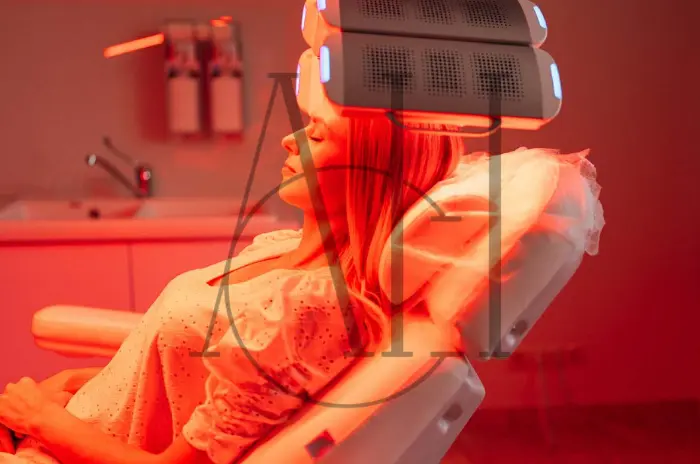
How Can You Help Boost Hair Growth Further?
Alongside RLT, consider integrating these practices:
- Use mild, sulfate-free shampoos
- Massage scalp regularly to stimulate follicles
- Maintain a balanced diet rich in biotin, zinc, and iron
- Stay hydrated
- Limit heat styling and chemical treatments
Does Red Light Therapy Actually Help with Hair Loss?
Clinical evidence and user testimonials suggest that consistent use of RLT devices can reverse early-stage hair loss, improve hair density, and strengthen existing hair strands. It is most effective when combined with other treatments or lifestyle changes.
How Do You Use Red Light Therapy for Hair Loss?
- Apply the device 3–4 times a week for 15–20 minutes
- Clean scalp before application
- Use consistently for at least 3 months
- Follow manufacturer instructions for optimal results
What Other Treatments Can Help With Hair Growth?
- Start By Tracking Your Hair – Monitor shedding and thickness
- Improve Your Scalp Health – Use exfoliating masks, oils, and treatments
- Use Hair Oils – Rosemary, castor, pumpkin seed oil
- Try Hair Loss Medication – Minoxidil, finasteride
- Use Hair Transplants – For advanced or irreversible hair loss
Red light therapy devices
- Red light therapy mask – Covers face and scalp; often used in skincare
- Red light therapy bed – Full-body application; available in medical spas
- Red light therapy panel – Wall-mounted or portable; offers high power
- Red light therapy wand – Handheld, ideal for targeted scalp areas
What the Evidence Says About Hair Loss Treatment
- FDA Clearance – Indicates safety and proven efficacy
- Laser Diodes vs. LEDs – Lasers penetrate deeper, LEDs are gentler
- Energy and Wavelength Specificity – 630–670 nm ideal for hair regrowth
Choosing the Right Device
- Look for FDA-Cleared Devices – Ensures safety and effectiveness
- Consider Proven Technology – Check for clinical trial data
- Beware of Marketing Claims – Avoid devices that promise overnight success
- Consult a Specialist – Especially for persistent or severe hair loss
Who is Suitable for Red Light Therapy?
- Men and women with early-stage androgenetic alopecia
- Individuals with thinning hair or reduced density
- Those experiencing post-partum or stress-related shedding
- Patients seeking a non-invasive, side-effect-free treatment
FAQ :
What is red light therapy for hair growth?
Red light therapy uses low level light to stimulate hair follicles and encourage growth.
How does red light therapy work to promote hair growth?
It improves blood circulation, boosts ATP production, and reduces inflammation.
Is red light therapy effective for treating hair loss?
Yes, clinical studies show increased hair count and thickness with consistent use.
Are there any side effects associated with red light therapy?
Side effects are rare but may include slight irritation or redness.
How often should I use red light therapy for hair growth?
Typically 3–4 sessions per week for 15–20 minutes.
Can red light therapy be combined with other hair loss treatments?
Yes, it complements treatments like PRP, minoxidil, and healthy lifestyle changes.
What types of devices are available for red light therapy at home?
Masks, panels, caps, wands, and beds are commonly available.
Who is an ideal candidate for red light therapy?
Anyone with mild to moderate hair loss seeking a non-invasive option.

